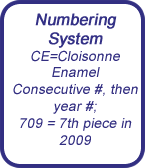Home | The Artist | Crosses | Paintings | Graphic Art | Sculptures | Liturgical Art | Jewelry
510 West Hills Way NW • Salem, Oregon 97304 • (503)949-6641 cell • Contact Us
©2014 JoelNickelArt • All Rights Reserved.


What does the mark of the cross signify? Two lines intersect: one is horizontal and the other is vertical, and their crossing bears heavy significance. The cross is the sign of Christianity, but is often rendered ineffective by overuse, poor design and thoughtless decoration. Consider this: the cross is the structure used to execute Jesus of Nazareth. Used for capital punishment by the Romans, the cross was both a scandal and frightening. (continued in right hand column)
A pectoral cross or pectorale (from the Latin pectoralis, "of the chest") is a cross that is worn on the chest, usually suspended from the neck by a cord or chain. In ancient and medieval times pectoral crosses were worn by both clergy and laity, but by the end of the Middle Ages the pectoral cross came to be a special indicator of position worn by bishops . . . In many Christian denominations, it is a sign that the person wearing it is a member of the clergy and it may signify that the wearer is a member of the higher or senior clergy; however, in many Western churches there are an increasing number of laypeople who choose to wear some form of a cross around their neck. While many Christians, both clergy and laity, wear crosses, the pectoral cross is distinguished by both its size (up to six inches across) and that it is worn in the center of the chest below the heart (as opposed to just below the collarbones).(Wikipedia)
These pectoral crosses were designed to fit a particular season of the church year. (click on a cross to enlarge and display as a slide show)
These pectoral crosses are sculpted with silver and mounted on ebony. No two cross designs are ever alike. Sometimes the images are abstract and geometric; sometimes semi-abstract with reference to body shapes. (click on a cross to enlarge and display as a slide show)
Through the centuries there have been many different cross patterns: the Latin cross, Greek cross, Jerusalem cross, Coptic cross, Celtic cross, Maltese cross and hundreds of variations, connecting the vertical and horizontal, heaven and earth. The cross is a “kerygmatic” sign, proclaiming a strange divine reality in the midst of human history, with power to reverse our egocentric values and revise our conventional ideas about God.
The cross is a paradox. On the one hand it is rooted in the ground, dug into the soil, connected to our earthly circumstances, heavy with brokenness. On the other hand the cross of Christ sheds heavenly light into our lives with hope and grace. On one hand the cross is a sign
of extreme cruelty but on the other hand it is a sign of love, a sign of shame and a sign of glory, of weakness and of power, of abandonment and of victory. St. Paul claimed that the cross represents “the foolishness of God that is wiser than human wisdom, the weakness of God that is stronger than human strength,” and we could add, the ugliness of the cross is more beautiful than human beauty.
In a century where holocausts are real and violence is no stranger, God is still in Christ, reconciling the world to himself. The cross is His sign. We should give it more than a passing glance.